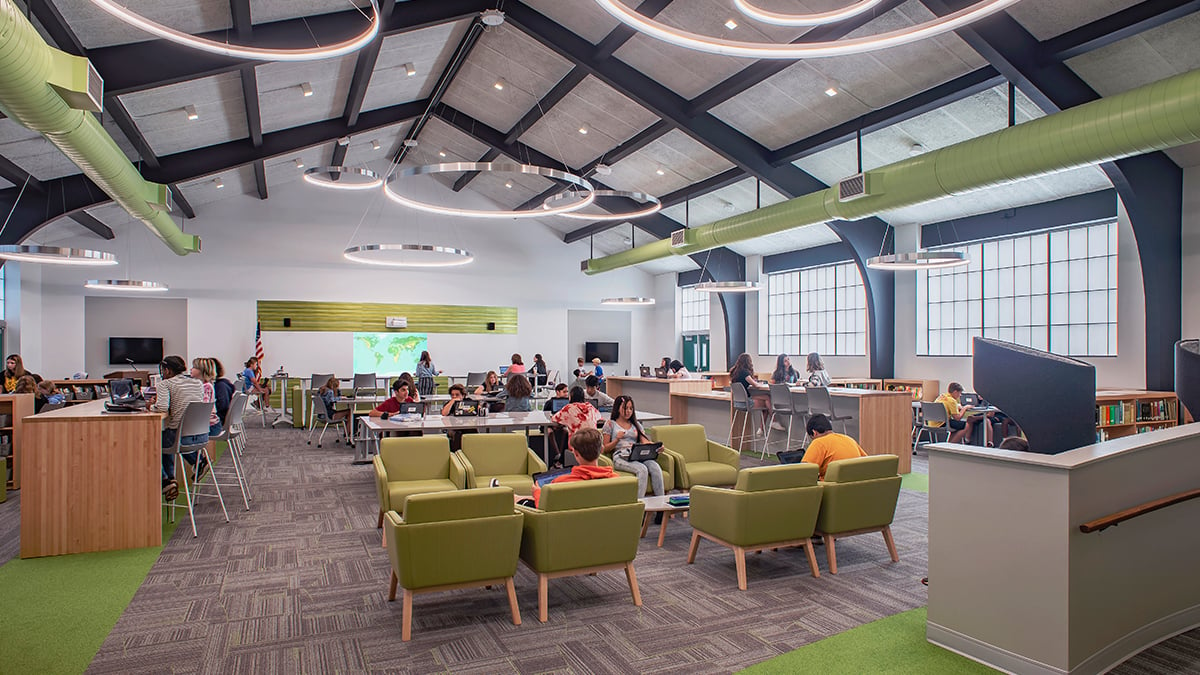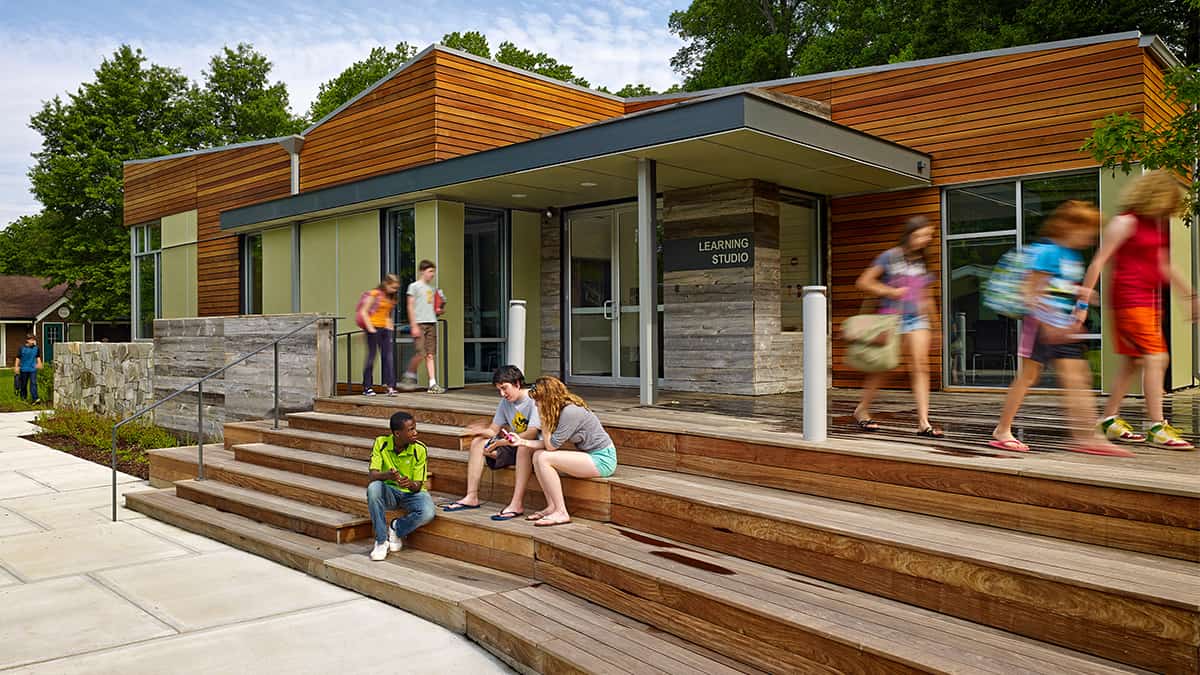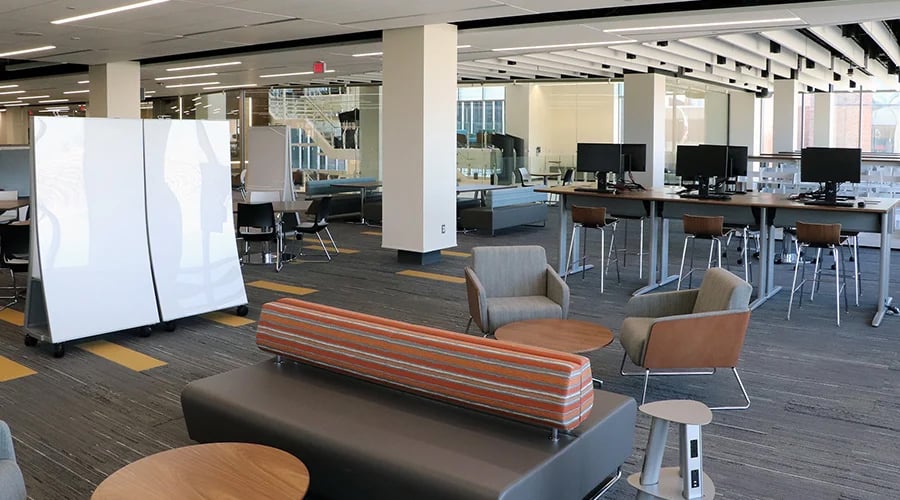- What's New
- Pricing & Purchasing
- Lead Times
- Literature & Samples
- Services & Warranties
- Careers
- Find a Rep
How to Create a School Library Your Students Will Love

Libraries provide students of all ages with a place for discovery and exploration. Here are six of our best tips for creating a school library tailored to your students’ needs.
School libraries have changed a lot in the last few decades. Encyclopedias are out. Laptops, tablets, and all modes of technology are in.
Today’s students have different learning habits and goals than their forebears. Various study spaces, such as libraries, should reflect those differences. To better support today's students, you can integrate intentional library design strategies to create an uplifting environment where students will foster a love of reading, learn new technology, and connect with peers.
And how exactly can you do that?
Follow these six tips for creating a library or media center that meets the diverse needs of your students. Also take note of valuable insights from former school librarian, Blake Hopper.
1. Emphasize Restoration
Gen Z students feel more stressed than students in previous generations, in part due to external pressure to succeed academically. In fact, research published earlier this year shows that higher standardized test scores and students’ perceptions of academic competition among their peers are correlated with teen anxiety.
Libraries can alleviate some of that pressure by offering students a space to recharge and take a mental health break. Designate quiet areas so students can decompress in the midst of a busy day. Be mindful of color and light stimuli. When selecting color schemes, opt for cooler tones and colors, which are more relaxing. Even artificial sunlight and plants have been shown to improve mood and promote calmness.
Blake Hopper, long-time librarian and current assistant principal at a middle school in Tennessee, shared with us how the library can be a refuge for students of all ages. He recommends including accessories that help distinguish quiet spaces for relaxation. At his school’s library, he included puzzles, board games, and coloring sheets in recharging spaces.
“Students don’t have to read or work the entire time they’re in the library,” he said. “They can come in and know the library is a safe place where they can be calm.”
He also opens the library during lunch so that students observing Ramadan have a place to hang out beyond the cafeteria.
“It’s important to have spaces available to support all members of the community,” he said.
2. Balance Technology & Books
Screen time is now learning time. Students of all ages rely on technology for at least some of their schoolwork. But surprisingly, many students find physical books and magazines to be a welcome departure from their day-to-day technology usage. In a Spaces4Learning profile of a Missouri high school, students said they found “the tactile experience” to be a “refreshing break from the intangible digital world.”
Libraries create an opportunity for younger kids to fall in love with reading, which teaches them syntax, language, and expression skills they can carry with them as they grow. Hopper suggests intentionally placing book displays in prominent locations to get kids excited about different authors, genres, or subjects. Consider providing dedicated spaces for books and magazines and comfortable seating areas where kids can curl up and read.
That said, today’s libraries must make it easy for students to access technology. Hopper recommends that libraries employ makerspaces to promote STEM alongside reading. Electronics, 3D printers, and even building blocks like Legos can inspire kids of all ages to design, engineer, and play.
Functionally, libraries should be designed with abundant opportunities for students to plug in their laptops or tablets. Integrating power into worksurfaces and even lounge furniture is a great way to make sure kids can study in their favorite spot for as long as they need.
3. Make Space for Student Support
As technology evolves, media centers should evolve with it. That may mean providing designated areas where students can ask for and receive assistance with technology. Consider starting a help corner or resource desk so students have easy access to expert advice from school staff and librarians.
Hopper designed his library so that his desk is in the center with a 360-degree view. If a student looks lost, he’s able to guide them to what they’re looking for. His central location ensures kids always know where to find him if they need help with anything.
For older or more independent students, a readily available troubleshooting guide may be all that they need to sort through basic problems with technology or to teach themselves how to use new tech tools.
4. Give Students Choices
Students have different work styles. Libraries and media centers should reflect those differences so every student can find a place that suits them.
Vary seating areas and study spaces to designate silent, quiet, and collaborative areas. Include both desks and chairs for independent study and tables for collaborating. Some students may work best on communal lounge furniture if they’re ideating with their peers. Solo study rooms or pods may be more appropriate for students with work that demands focus.
“Make sure you have furniture that can fit all types of learners,” Hopper recommended, noting that kindergarten students will gravitate toward different sizes and varieties of furniture than bigger kids. “We ordered different styles so everyone can enjoy the library.”
5. Prioritize Open Space
Most students still spend most of the day seated next to their peers in small classrooms. Libraries should feel different. They can be a refuge from the classroom status quo by offering students freedom in their learning and movement.
When possible, opt for open spaces and mobile furniture. The heavy, wooden chairs characteristic of traditional libraries aren’t easy for adults to move around, much less for younger kids. Avoid arranging furniture in rows or constricting layouts. Include spaces where students can study or work alone but in an open setting.
Accessibility in design is paramount to ensuring every student is comfortable and welcome in the library. Consider how the layout can invite people with all abilities to move around the space.
“Libraries should accommodate all kinds of learners and all kinds of bodies,” Hopper added.
6. Make It Specific to Your School
When designing or refreshing your library or media center, reflect on what makes your school or town unique and then fashion your space accordingly.
Perhaps a library decked out in school colors or incorporating mascots into the aesthetic is right for you. Consider highlighting local authors or book topics that are relevant to your student body. Student artwork or awards for achievement could deck the walls.
Hopper recommends personalizing the books available based on student input. “At the beginning of the year, we surveyed the kids and made lists of the books they wanted to see,” he said. “They don’t all have to be novels. Maybe you incorporate books on football or even snakes depending on what kids are interested in.”
Dedicated Space for Discovery & Exploration
Ultimately, media centers can provide the space where students fall in love with learning, whether that’s discovering books they enjoy for the first time or uncovering their passion for a new topic or activity.
In a world that is increasingly anchored around all things digital and online, school libraries have taken on a new life as a hub of the school that serves as a source of stability, comfort, and exploration.
We invite you to explore K-12 library design ideas in our applications gallery. Peruse these space planning scenarios and consider these six tips as you formulate the ideal library space for your school.
Then, bring that vision to life by using our Classroom Planner tool! Design your dream layout and enter your rendering in our learning space design competition by December 31 for a chance to turn your vision into reality.
BONUS CONTENT
Find additional library design strategies and case studies in our takeaways from EDspaces 2023.
Related Content
 Blog
Blog
Now more than ever, it's important to create learning spaces that alleviate stress and are sensitive to mental health needs.
 Blog
Blog
Learn how universal design creates an environment that adapts and responds to students' individual needs in a way that’s impactful for everyone.
 Blog
Blog
Discover KI's top five design strategies for creating libraries, including advice for designing in the wake of the pandemic.
Subscribe
Stay up to date with the latest trends and more.





















